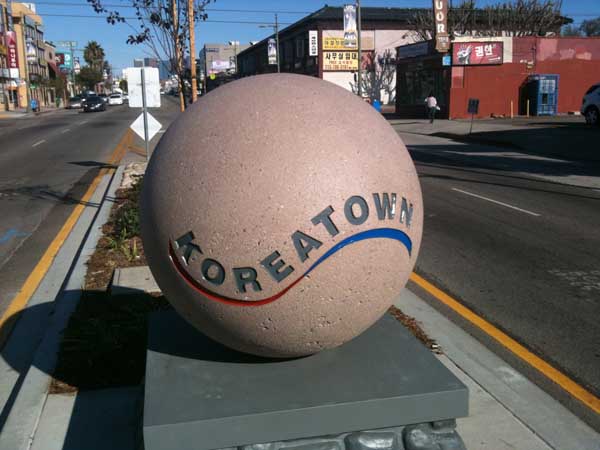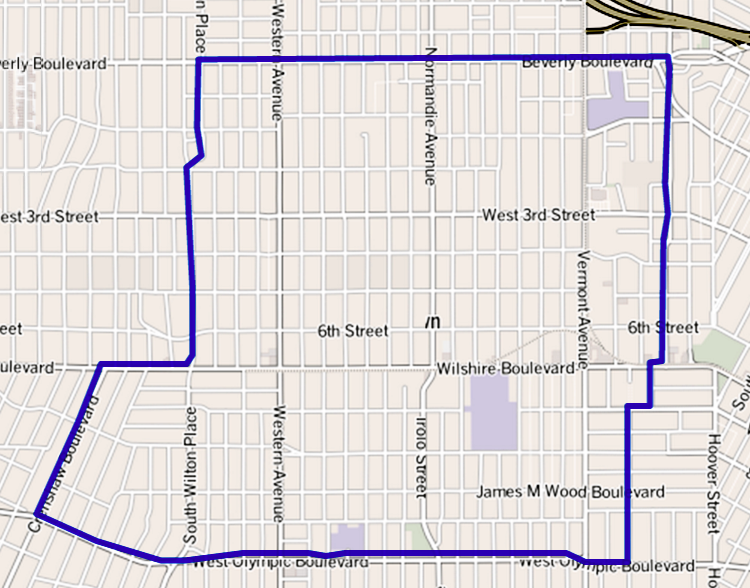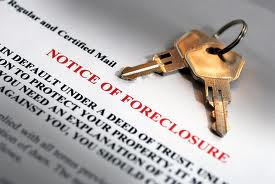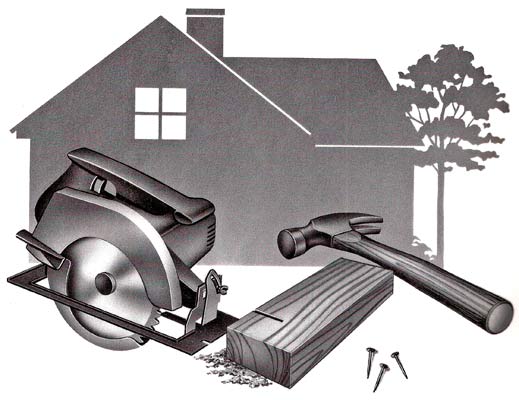
BLOG
Crenshaw Line Is Really Coming! - Green Line
After a long haul and many battles the Green Line is coming to Crenshaw!
Not sure how much you have been following along but the Crenshaw District IS getting its own Light Rail/Subway. Last week the planned light rail received a boost from the Metropolitan Transportation Authority staff recommending a $1.27 billion contract to build the line. The Line will begin at The Aviation Station along the Green Line, travel north along La Cienaga( meet a soon to be people mover at Century Blvd that will that take travelers directly into the soon-but-not-too-soon Grand Terminal at LAX), touch the eastern tip of Westchester with a station at Hindry to serve the Westchester community. The Light Rail will hit a slight right along Florence, cutting through Downtown Inglewood and finally hitting Crenshaw Blvd in Hyde Park at Crenshaw and Florence. The train will continue north along Crenshaw all the way to expo, submerging underground after Slauson Ave. with a subway stop at Leimert Park at or around Vernon amd another subway stop at MLK Blvd with a underground entrance to the Baldwin Hills Crenshaw Plaza. Bravo!
On June 27, the full Metro board is scheduled to vote on the contract and whether to approve Walsh/Shea Corridor Constructors as the contractor.
Source: SouthLA: Crenshaw on the Move
The Great BBQ Debate! Charcoal vs. Gas
It's an age old debate among BBQ lovers all over the country! Charcoal vs. Gas! Before your buy your grill - you should do a little research!
The debate over charcoal versus gas is one you don't want to get in the middle of. The one simple thing you need to know is that it is a matter of taste and convenience. To gain a broader view of the whole range of grills, add to this list electric grills, pellet grills and hardwood cooking as well.
Convenience: The best way to think about this problem is to remember that the more convenient a grill becomes the less smoke flavor it produces. An electric grill is the easiest to use, but doesn't have that real fire flavor, while hardwood fires give you the best flavor, they are the hardest to deal with.
Authenticity: The authentic smoky, off the fire taste of grilled foods is strongest with the original heat source, wood. As you move to electric units, there is very little of this flavor left. In fact, many electric grills add virtually nothing to the taste of foods. However, the simplicity of flipping a switch and grilling, can't be beat.
Taste: On the subject of taste, a study conducted a while back, participants were presented withhamburgers and steak cooked on gas and charcoal units. No one could tell the difference between the charcoal or gas when it came to the hamburgers, but they could tell the difference with the steak. The charcoal grilled steak had a distinct smoke flavor.
Space: To decide what kind of grill is right for you, consider where the grill is going to sit. A small patio or covered area is not the place for a large charcoal grill. Electric grills produce no flare-ups and are safer in smaller areas. Gas grills do produce flare-ups and need to be away from any structure to avoid those pesky house fires. Charcoal can be lit with an electric starter and therefore, used with virtually no open flame.
Grilling: Another thing to consider is how you plan to grill. If you want to come home from work and throw a couple of steaks or chicken breasts on the grill with virtually no hassle, then an electric or gas unit might be what you are looking for.
Cost: Finally, there is the issue of cost. Gas grills are generally more expensive than electric or charcoal; charcoal being the cheapest. If you don't want to spend a lot of money then charcoal might be the answer. However, charcoal is the more expensive fuel. You can easily spend $5.00USD a cookout on charcoal, while gas might cost around $.20USD per cookout. Charcoal won't save you money in the long run.
Ready to have your own BBQ Parties in your OWN backyard! Start your home search here!
Source: By Derrick Riches, About.com Guide
Rare Opportunity to Buy by the Beach!
What a wonderful opportunity to live your dream of living by the beach! Redondo Beach to be exact! Call me for a scheduled showing! Laura Key 310.866.8422
630 The Village Unit 110 Redondo Beach, CA
$385,000
1 Bed 1 Bath 621 SqFt - HUD
Click Photo for Virtual Tour!!!
Call me today! Laura Key 310.866.8422!
Experienced HUD Selling Agent!
Laura Key on CBS News
Appraised Value: The Ups & Downs Of How Much A House Is Worth
How is the fair market value of a real estate property actually determined?
Determining Fair Market Value is an eternal struggle and major balancing act. That’s because buyers want a house to appraise on the low side—to keep the purchase price down. While sellers want the same house to appraise on the high side—to make the sale price higher. And then you’ve got the owners of the house—who also want the appraisal to be on the low side, in order to keep the property taxes down.
So with all these different agendas and points of view, how is the fair market value of a real estate property actually determined?
Once a year, your county sends all area homeowners official notices that put a dollar value on their property. And property taxes are based on those dollar values. But before those notices get sent out, a long, detailed process usually takes place. First, the land is valued as if it’s vacant—an empty lot, in other words. Then any improvements are described and measured. Improvements consist of the house and any other structures, pools, sheds, garages, and so forth. Next, most counties check the Marshall Valuation Service Cost Guide. It’s a standardized nationwide guide for determining the value of the cost per square foot to build a building that fits the description of the improved property. Next, if the house isn’t brand new, the replacement cost is considered, as well as depreciation; the year the house was constructed and the condition of the property are factors here. Appraisers then must take the critical step of comparing the value of the house with recent selling prices of similar homes in the neighborhood. At this point, the appraisal might stand “as is”—or it might be adjusted upward or downward.
Market Value is a theory, in other words—not an unchanging fact.
In a perfect world, you have to have willing buyer and a willing seller. Neither is under duress. Both are in a position to maximize gain and are trying to do this. But in the real world, things are rarely that simple and equally balanced. Which is why people feel differently about the appraisal value of a house. It really depends how strong their position is as a buyer or seller.
Does the local economy come into it at all? You bet it does.
Ask a successful Realtor about that! He or she will tell you they’ve noticed that the Rio Grande Valley’s fast-growing economy is attracting people from other areas who consider real estate here a bargain. That helps fuel increases in property values.
So—now you know where that Grand Total comes from.
You’re armed with the information you need to make a better house-buying decision. For instance, you can understand how two virtually identical houses that are in two different neighborhoods could be very far apart in price and appraised value. And why your choice of the right house in the right neighborhood could be worth a not-so-small fortune to you right now—and years down the road.
Sellers! You can get a great idea of how much your home is worth! Call me for a FREE Comparative Market Analysis (CMA) Laura Key 310.866.8422
5 Things You Should Know Before You Flip A Property
Money is made at the buy, not the sell of your flip. When flipping a house your money is made at the purchase not at the sell of the house. So, many times people buy a house with the intentions of making a huge profit only to find out that they could not make any money after all the renovations because the purchased price of the house was to high.
1. Money is made at the buy, not the sell of your flip. When flipping a house your money is made at the purchase not at the sell of the house. So, many times people buy a house with the intentions of making a huge profit only to find out that they could not make any money after all the renovations because the purchased price of the house was to high. When you purchase your property you need to be sure that you buy the house with enough money to make renovations, have carrying cost, and add about 5 $6,000. Now, cost is at $147,000, and that is if everything goes as planned. Profit is under 10,000 dollars. The mistake was made at the purchase at the home, not the sell.
2. Get an inspection on the home - Get a complete inspection done on your property. By, spending a few hundred dollars on this expense you can save thousands in problems that you cannot see. Foundation, Pest, Wood Rot, Etc... By, getting a full inspection you can rest assured that you know every thing that is wrong with the property before its to late. In the contact for the house you need to make sure that you have 7 days to have a inspection preformed, and if the inspection finds problems that are going to cost more money that you are willing to spend you can get out of the contract with no penalties.
3. Don't do the work yourself: - Get a contractor or several sub-contractors and have the work done quickly. You need to have you house flipped ASAP, so that you can get it on the market and get it sold. When I started flipping my brother and me did a house together, and we did all the construction. I had a construction background and figured it would save thousands, but it took us over 4 months to get the work done that a contractor could have had the work done in a month. But, we trying to save money on our flip did all the work on our time off and after work, and it just took to long. On our 2'nd flip we used contractors for almost everything and had the house completely flipped with a new roof, new air conditioning, new hardwood, and much more in only 3 weeks. We did not have to spend all our time working on the property and were able to spend that time looking for the next deal. This is how you get rich in real estate.
4. Place the property 1 to 2 percent below market value: If you are wanting to flip real estate and make money the object is to buy and sell the property as quickly as possible, so that you can move on to the next house. If you purchase a house and try to sell it at top dollar to make and extra couple of thousand dollars on your flip, and end up holding it for 6 months you are loosing money. Get the house on the market at a price that is going to blow the competition away, and you will sell it no matter what the market conditions. On our second house the market for selling house went down do to the housing market as a whole, and the tightening of the loans across America. We were told that you could not sell a property in this market, but we went ahead anyway and flipped our house. After 3 weeks on the market we had 3 people wanting to buy the house. Why, because we offered it at such a great deal that people wanted to jump on it. That is what you have to do especially if the market is slow.
5. Use a real estate agent - Do not try to sell you house on your own. Harness the power of a real estate agent and the power of the MLS system. When you do a FSBO you are depending on people driving by your house and seeing you sign, with a real estate agent you have someone actively marketing you house to get it sold. Once again this will free up more time for you to look for more great deals. If you want to help the process I have found that craigslist and listing you house in google adwords help to, but use these tools with the help of a agent such as Laura Key to make sure I have all my bases covered.
I hope this article has been helpful with the basics needs of flipping a house. If you will study and learn you will make money. But, do your homework before you purchase a house, and make sure that you can pull a profit on your deal. Then, make it happen! I am a Investor Friendly Agent, let's get you some deals! Laura Key 310.866.8422
Laura Key on CBS News
Great Burbank HUD Home! 2 Bed 2 Bath
HUD Homes are a wonderful way to purchase your first home! Most are FHA approved and don't need much work at all. Make sure you use a HUD experienced agent as myself! I have helped many families obtain their Home Dreams with HUD! Call me today for more info! Laura Key 310.866.8422
2359 N. Reese Place
Burbank CA 91504
DIY Bucket List
This is a wonderful story about making their house a home! With so many options out there today it's hard to choose what you want in your own home.
More Sellers Jump Into Favorable Market
More sellers are ready to put their homes on the market for the awaiting buyers. They are getting top dollar! If you have been thinking of selling, give me a call for a FREE Comparative Market Analysis and let's begin the process! Laura Key 310.866.8422
Inventories of for-sale homes are increasing as more owners see rising home prices and faster sales as a reason to try to sell now, according to industry reports.
In April, the number of listings was higher than the level of homes that were under contract in that month, according to a study by the real estate brokerage ZipRealty, which measured listings in 24 major metro markets.
“It’s less of an indication of buyer momentum flagging and more of seller momentum picking up, finally,” says Lanny Baker, the company’s chief executive.
The reports find that homes are selling faster—on average, within 32 days of being listed. In April 2012, that average stood at 48 days for homes to sell.
“A market in which the sale prices are happening very close to the list prices, a market in which the list prices seem to be moving sequentially higher, and a market in which any of those houses are selling speedily is one that is bringing sellers back,” Baker says. “That makes it feel to a seller that this isn’t going to be a long passive despair that I tried three years ago.”
Source: “Why More Sellers Could Test the Market,” The Wall Street Journal (June 10, 2013)
Want an estimate of what your California home is worth? Fill out the form below! All info is confidential and will not be sold!
[contact-form][contact-field label='Name' type='name' required='1'/][contact-field label='Email' type='email' required='1'/][contact-field label='Address' type='text' required='1'/][contact-field label='City%26#x002c; State%26#x002c; Zip' type='text' required='1'/][contact-field label='Number of Bedrooms' type='text' required='1'/][contact-field label='Number of Bathrooms' type='text' required='1'/][contact-field label='When are you interesting in putting your home on the market?' type='select' options='0-3 Months,4-6 Months,7-9 Months,10-12 Months'/][contact-field label='Please enter any other important features about your home? Upgrades%26#x002c; Garage%26#x002c; etc.' type='textarea' required='1'/][/contact-form]
Do Pets Make A Home Complete?
Some say a house is not a complete home without a pet? What are your thoughts? Meet Chewbacca and Fizgig, my furry babies!
 I grew up in the country in a little country town in Kentucky. When I was coming up we only had outdoor pets. So naturally 11 years ago when my husband and I purchased our first home I started to get the gentle heartstring plugs of wanting a dog. After much discussion and concern due to allergies, we proceeded to head out and get Chewbacca who is a full blood Shih Tzu. Chewbacca is gentle, warm, kind loving, and just a special being and I enjoy having him around. Well, after two years we thought maybe Chewbacca needed a companion. So off we went and ended up with Fizgig who is also from the same parents of Chewbacca but has a totally different view on life. He's stubborn, he barks, he is a little Tasmanian devil. But he is still my furry baby and both of my pets do something every single day that warms my heart and lets me know they love me as much as I love them. It's nothing like coming home to two little warm fuzzy faces who are happy to see you. Chewbacca and Fizgig bring both my husband and I untold joy!
I grew up in the country in a little country town in Kentucky. When I was coming up we only had outdoor pets. So naturally 11 years ago when my husband and I purchased our first home I started to get the gentle heartstring plugs of wanting a dog. After much discussion and concern due to allergies, we proceeded to head out and get Chewbacca who is a full blood Shih Tzu. Chewbacca is gentle, warm, kind loving, and just a special being and I enjoy having him around. Well, after two years we thought maybe Chewbacca needed a companion. So off we went and ended up with Fizgig who is also from the same parents of Chewbacca but has a totally different view on life. He's stubborn, he barks, he is a little Tasmanian devil. But he is still my furry baby and both of my pets do something every single day that warms my heart and lets me know they love me as much as I love them. It's nothing like coming home to two little warm fuzzy faces who are happy to see you. Chewbacca and Fizgig bring both my husband and I untold joy!
In case you are wondering where the names came from, my husband is a movie buff. Of course most know Chewbaccca is from Star Wars but most do not know where the name Fizgig came from. Fizgig has his name from the little dog like creature in "The Dark Crystal" and if you know that movie, then you know exactly how my little monkey acts!
So what are you thoughts? Is a house not a complete home without a pet?
Ready to create memories in your own home? Start your journey by attending a FREE homebuyers workshop. You will find info from credible lender's, the homebuying process taught by me, and lots more such as...what is escrow...Do I have to have an inspection? Contact me today for a class schedule!
Home is Where the Heart Is? Are You Ready?
Home is where you create wonderful memories! One of my favorite things is when my family comes for the holidays and we all gather in the kitchen and work on dinner. We have so much fun laughing and preparing dishes that have been handed down through the generations. Then after dinner we gather around piano and sing, sing, sing! Home.....are you ready?
Find your home now for free! Click below!
Return to 'Buyer's Market' Still Years Away
Even though it's tough for buyers right now, I never say it's IMPOSSIBLE! Buyer who are patient and stay the course can find a home! Call me today! Free Homebuyers classes coming soon! Register Now! Laura Key 310.866.8422
It may be two to three more years before prospective home buyers get a break from escalating property prices and tight supply, according to experts speaking at a National Association of Real Estate Editors conference Wednesday.
That is the time frame for institutional speculators, who currently are dominating the market, to pull out of their investments and still make a profit, explained Bill Rayburn of the mortgage technology firm FNC. The market also will need to see the return of individual home buyers in order to normalize, he said, which will be propelled by employment gains.
Source: "Better Times for Home-Buyers Will Take a Few Years, Experts Say," Los Angeles Times (June 5, 2013)
Search for homes now...It's FREE!
Living in Koreatown Los Angeles
Los Angeles is home to so many wonderful areas to live in. If you are interested in Koreatown, give me a call! Laura Key 310.866.8422 or just click the Koreatown Ball below!
 Koreatown is a wealth of history and excitement! You can hardly take two steps without finding a new place to eat or shop! I must admit, after living here for almost two years I have not even scratched the surface of what is offered in this great area of Los Angeles until I saw the CNN Special with Anthony Bourdain Parks Unknown! Sometimes the boob tube can really spur you into action.
Koreatown is a wealth of history and excitement! You can hardly take two steps without finding a new place to eat or shop! I must admit, after living here for almost two years I have not even scratched the surface of what is offered in this great area of Los Angeles until I saw the CNN Special with Anthony Bourdain Parks Unknown! Sometimes the boob tube can really spur you into action.
I decided it was time to visit some of the places shown during this special. My first adventure was trying Myung In Dumplings located at 3109 W. Olympic Blvd. The power of TV had already overwhelmed this place. The first time my husband and I visited they had sold out of most of their menu, so we attempted to fill our bellies on another day! On our second visit we were able to order the #1 which is meat and veggie dumplings. While we were in line waiting it was such a pleasure to watch the owners actually making the dumplings by hand. It's something about seeing loving hands prepare food. Reminds me of growing up in Kentucky and our Sunday dinners! For $7 we were given four nice sized fluffy dumplings filled with yummy delights on the inside! Along with our dumplings we were given a few kimchee delights!
Overall, it was a very pleasant outcome to my first new adventure of Koreatown! Join me on my next adventure in the near future!
Interested in living in Koreatown? Please visit my website to search for homes FREE! Just click the map below! Or...call me, Laura Key 310.866.8422
California Homebuyers Need Homes!
If you can't see the video from the photo please click here: http://www.cbsnews.com/8301-18563_162-57587256/home-flipping-trend-returns-threatening-higher-prices/
Are you thinking of selling? I have buyers! Call me and let's reach your Real Estate Goal! Laura Key 310.866.8422
4 Big Drivers of the Housing Market Recovery
There seems to be a light at the end of the tunnel and it's getting brighter each day! Let's Get YOU a home! Laura Key 310.866.8422
The Wall Street Journal highlighted four primary reasons why the housing market recovery is strong. They are:
- Sales have made big leaps from year-over-year levels. Existing-home sales are up 9.7 percent compared to one year ago. Sales are at an annual rate of 4.97 million, which is the highest level since November 2009, according to NAR. Despite constrained inventories and recent price gains, home sales continue to post increases.
- Non-distressed home sales are increasing. Home buyers are showing high demand for non-distressed homes. In April, about 18 percent of sales were in foreclosure or a short sale — down from 28 percent year-over-year.
- Inventories have increased. In April, the number of homes for sale rose 11.9 percent from March. The limited supply — mixed with rising buyer demand — has helped home prices to rise around 10 percent year-over-year. “Rising inventory should ultimately slow some of the price rally while boosting sales volumes, helping to restore equilibrium in the housing market,” The Wall Street Journal reports.
- Homes are selling a lot quicker. About half of all homes that were sold in April were on the market for 46 days, down from 83 days one year earlier, according to NAR data.
Search for your next home FREE! Visit me on Facebook and search NOW!
Source: “Four Reasons Why Home Sales Are Looking Healthy,” The Wall Street Journal (May 22, 2013)
When It Comes to Wood Floors, Choose Wisely
Rich wood flooring can spell instant warmth and patina in a home. Here’s an overview that can help you evaluate if wood floors are right for you! Laura Key 310.866.8422
Just as with ties and hem lengths, wood flooring styles change. Colors get darker or lighter; planks get narrower or wider; woods with more or less grain show swings in popularity; softer or harder species gain or lose fans; and the wood itself may be older, newer, or even pre-engineered with a top layer or veneer-glued to a substrate to decrease expansion and contraction from moisture.
Here are key categories for consideration:
Solid Plank
This is what some refer to as “real” wood because the wood usually ranges from three-eighths to three-quarters of an inch in total thickness to permit refinishing and sanding. Thicker floors have a thicker wear layer to allow for more frequent refinishing and sanding, so they can withstand decades of use, says architect Julie Hacker of Stuart Cohen and Julie Hacker Architects. It also can be stained, come from different species of tree, and be sold in numerous widths and lengths:
- Width and length: Designer Steven Gurowitz, owner of Interiors by Steven G., is among those who prefers solid flooring for many installations because of its rich, warm look. Like other design professionals, he’s seeing greater interest in boards wider than the once-standard 2 ¾ to 3 ¾ inches — typically 5 to 6 inches now but even beyond 10 inches. And he’s also seeing corresponding interest in longer lengths, depending on the species. Width and length should be in proportion. “The wider a board gets, the longer the planks need to be, too, and in proportion,” says Chris Sy, vice president with Carlisle Wide Plank Floors. These oversized dimensions reflect the same trend toward bigger stone and ceramic slabs. The downside is greater cost.
- Palette: Gurowitz and others are also hearing more requests for darker hues among clients in the northeastern United States, while those in the South and West still gravitate toward lighter colors. But Sprigg Lynn, on the board of the National Wood Flooring Association and with Universal Floors, says the hottest trend is toward a gray or driftwood. Handscraped, antique boards that look aged and have texture, sometimes beveled edges, are also become more popular, even in modern interiors, though they may cost much more.
- Species and price: Depending on the preference of the stain color, Gurowitz favors mostly mahogany, hickory, walnut, oak, and pine boards. Oak may be the industry’s bread and butter because of the ease of staining it and a relatively low price point. A basic 2 ¼-inch red oak might, for instance, run $6.50 a square foot while a 2 ¼-inch red oak that’s rift and quartered might sell for a slightly higher $8.50 a square foot.
- Maintenance: How much care home owners want to invest in their floors should also factor in their decision. Pine is quite soft and will show more wear than a harder wood like mahogany or walnut, but it’s less expensive. In certain regions such as the South, pine comes in a harder version known as heart pine that’s popular, says Georgia-based designer Mary Lafevers of Inscape Design Studio. Home owners should understand the different choices because they affect how often they need to refinish the wood, which could be every four to five years, says Susan Brunstrum of Sweet Peas Design-Inspired Interior. Also, Sy says that solid planks can be installed over radiant heating, but they demand expert installation.
Engineered Wood
Also referred to as prefabricated wood, this genre has become popular because the top layer or veneer is glued to wood beneath to reduce expansion and contraction that happens with solid boards due to climatic effects, says Sy, whose firm sells both types. He recommends engineered, depending on the amount of humidity. If home owners go with a prefabricated floor, he advises a veneer of at least one-quarter inch. “If it’s too thin, you won’t have enough surface to sand,” he says. And he suggests a thick enough substrate for a stable underlayment that won’t move as moisture levels in a home shift.
His company’s offerings include an 11-ply marine-grade birch. The myth that engineered boards only come prestained is untrue. “They can be bought unfinished,” he says. Engineered boards are also a good choice for home owners planning to age in place, since there are fewer gaps between boards for a stable surface, says Aaron D. Murphy, an architect with ADM Architecture Inc. and a certified Aging in Place specialist with the National Association of Home Builders.
Reclaimed Wood
Typically defined as recycled wood — perhaps from an old barn or factory — reclaimed wood has gained fans because of its aged, imperfect patina and sustainability; you’re reusing something rather than cutting down more trees. Though less plentiful and more expensive because of the time required to locate and renew samples, it offers a solid surface underfoot since it’s from old-growth trees, says Lynn. Some companies have come to specialize in rescuing logs that have been underwater for decades, even a century. West Branch Heritage Timber,for instance, removes “forgotten” native pine and spruce from swamps, cuts them to desired widths and lengths, and lays them atop ½-inch birch to combine the best of engineered and reclaimed. “The advantage is that it can be resanded after wear since it’s thicker than most prefabricated floors, can be laid atop radiant mats, and doesn’t include toxins,” Managing Partner Tom Shafer says. A downside is a higher price of about $12 to $17 a square foot.
Porcelain “Wood”
A new competitor that closely resembles wood, Gurowitz says porcelain wood offers advantages: indestructibility, varied colors, “graining” that mimics old wood, wide and long lengths, quickness in installation, and no maintenance. “You can spill red wine on it and nothing happens; if there’s a leak in an apartment above, it won’t be destroyed,” he says. Average prices run an affordable $3.50 to $8 a square foot. The biggest downside? It doesn’t feel like wood since it’s colder to the touch, Lynn says.
Bottom Line
When home owners are making a choice or comparing floors, Sy suggests they ask these questions:
1. Do you want engineered or solid-based floors, depending on your home’s conditions?
2. Do you want a floor with more natural character, or less?
3. What board width do you want?
4. How critical is length to you in reducing the overall number of seams?
5. What color range do you want — light, medium, or dark?
6. Do you want more aggressive graining like oak or a mellower grain like walnut?
7. Do you want flooring prefinished or unfinished?
8. How thick is the wear layer in the floor you’re considering, which will affect your ability to refinish it over time?
9. What type of finish are you going to use? Can it be refinished and, if so, how?
10. For wider planks that provide greater stability: Where is the wood coming from, how is it dried, what is its moisture content, and what type of substrate is used in the engineered platform?
Thinking of selling your home? A little investment can increase your resale value! Call me for a personal consultation! Laura Key 310.866.8422
Wells Fargo, Citigroup Halt Foreclosure Sales
Banks seem to be moving in the right direction on this action. But is it too late? Call me if you are in need of help! Laura Key 310.866.8422
Wells Fargo and Citigroup have temporarily halted foreclosure sales in several states, taking precautions after a federal regulator released new guidance on minimum standards for foreclosure sales.
The Office of the Comptroller of the Currency (OCC) recently released the new standards. The OCC’s directive mostly consists of 13 questions banks need to ask themselves before selling a home in foreclosure, such as whether the borrower is protected from foreclosure by bankruptcy or if the borrower is in an active loan modification plan.
JPMorgan had also mostly stopped its foreclosure sales after the OCC’s standards were released, but has since resumed sales.
Wells Fargo, the nation’s largest mortgage originator, has seen a dramatic drop in foreclosure sales while significantly decreasing the number of sales it’s processing. For example, foreclosure sales by Wells Fargo in California, Nevada, Arizona, Oregon, and Washington plummeted from 349 a day in April to less than 10 a day, according to Foreclosure Radar, a real estate monitoring firm based in California.
"Wells Fargo has temporarily postponed certain foreclosure sales while we study the revised guidance from the OCC," a Wells Fargo spokeswoman confirmed for American Banker. Citibank officials also confirmed the reason behind their halt in sales was to carefully review the new guidance.
"The OCC did not direct a slowdown or pausing," says OCC spokesman Bryan Hubbard. "However, if servicers are not certain they are meeting these standards, pausing foreclosures is a responsible and productive step."
Are you facing foreclosure? Contact me for a free consultation!
[contact-form subject='Help! Facing Foreclosure!'][contact-field label='Name' type='name' required='1'/][contact-field label='Email' type='email' required='1'/][contact-field label='Phone' type='text'/][contact-field label='Comment' type='textarea' required='1'/][/contact-form]
Source: “Wells, Citi Halt Most Foreclosure Sales as OCC Ratchets Up Scrutiny,” American Banker (May 17, 2013)What To Ask When Looking At Potential Homes
Buying a house can be an intimidating and overwhelming experience. Here are some key questions to ask yourself and sellers before plopping down a down payment. Let me help you with my FREE homebuyer's class! Call me today! Laura Key 310.866.8422
Buying a house can be an intimidating and overwhelming experience. Here are some key questions to ask yourself and sellers before plopping down a down payment.
What To Ask When Looking At Potential Homes
Following is a list of general questions you should always ask when considering making a real estate purchase. Keep in mind, however, you are unique.
You have particular dislikes and likes as well as factors in your life that are different than other people. The point I am trying to make is that you shouldn’t stick to just these questions. You are making an important choice, so give some thought to your situation.
1. Don’t rush into things. The first question to ask should be directed at yourself. What type of home do you want? How big should it be? What amenities do you want? Are you planning for a family in the next three to five years and will the home be able to accommodate a new bundle of joy? Make a definitive list and stick to it. If you stray from it, you could end up with a house that doesn’t really fit you and suffer buyer’s remorse.
2. The next question is what area do you want to live in? Pick a few. You may find the prices to be excessive or the selection not so hot, but make sure you exhaust those areas before moving on. Again, you want to avoid buyer’s remorse.
3. Once you start looking at homes, a key question to ask is how long the house has been on the market. The amount of time will give you an idea of how flexible the owner is on price. If the house has been on the market for a month, the owner isn’t going to be very flexible. If it has been on the market for six months, flexibility will definitely exist.
4. Has the house previously been in escrow, but fell out? If so, find out why? Was it a problem with the buyer getting financing or did the buyer find out there was something wrong with the home?
5. What kind of condition is the house in and how old is it? Remember that a seller has typically done everything reasonably possible to spruce up the home. If you can see wear and tear on the house, it may be a red flag. In such a situation, you need to get a home inspection to make sure there aren’t problems in areas you can’t see such as mold, rust and water leaks.
6. If you have children or are planning on it, you must investigate the school district. Are the schools good? Are there gangs or crime in the area?
7. In addition to the home price, you should ask whether there are any additional fees such association fees.
8. What are the property taxes and what will they be when you buy? Many people are shocked to find out how much they have to kick out in property taxes. Don’t get surprised.
9. Zoning and easement issues are often overlooked when buying a home. If you are buying in a neighborhood with many homes, zoning is undoubtedly going to be for residential living. Easements, however, can be nasty surprises. Find out if there are any easements on the property. An easement gives a third party the right to use of part of the property. This can include giving the neighbor the right to do something or a utility company to place structures on your prospective property.
10. Noise is another big issue to consider. If you are serious about the property, make sure to drive buy on weekdays and weekends. If the property shares a wall with another residence, such as a duplex or condo, make sure you view it while the neighbors are home to get an idea of how loud it is.
11. In the euphoria of buying a property, practical issues can be missed. A big one is traffic. Specifically, what is the commute like between the house and your place of work? You don’t want to buy the house only to find out it takes three hours to get to and from work each day.
Obviously, you should be asking many additional questions before making a purchase. These 11 questions, however, will help you get started. Call me to schedule a time to discuss the homebuying process in more detail. Don’t forget to look into fun things to do in the area to make sure it’s where you want to live!I care about my clients and educating them is a priority! Laura Key 310.866.8422 or email me at Laura.A.Key@gmail.com
What to Expect At a Foreclosure Auction
Whether you are an investor that would like to get into buying foreclosed homes for your personal use! Call me today! Laura Key 310.866.8422
Whether you are an investor that would like to get into buying foreclosed homes for your personal use or to flip the property or if you are having your home foreclosed on, you should know what to expect at a foreclosure auction. Of course, the actual steps that will be taken can vary a bit from state to state and from house to house, but it’s good to know what you will be getting into when you go to a foreclosure auction. Foreclosure auctions can be exciting, even fun, but knowing what to expect will help you make the most of the experience, whether you are an investor or a homeowner that is trying to get your house back.
Before the Auction
You’ll likely find out about the foreclosure auction in a local newspaper and on the flier may be information to pre-qualify for bidding. This will allow you to put down a deposit so that the auctioneer knows that you are a serious bidder and can fulfill your bid if you are the winning bidder. Being pre-qualified just sort of speeds up the process so that you don’t have to mess around with the deposit on the day of the auction. During this time you should also do some research on the house by looking into any liens that may be against the property, how much the property is worth, how much it has appreciated in the last few years, as well as property values in the area. If the home looks as though it will need some repairs, you should consider this as well when trying to come up with how much you will be willing to pay for the house. Without this research, no amount of knowledge about what goes on at a foreclosure option will help you because you won’t know where to start when it comes to actually making a good bid.
What Happens At the Auction
The auction will typically start with the auctioneer reading legal notices as well as a legal description of the property. The auctioneer will usually then begin taking bids on the property. If the auctioneer has pre-qualified bidders the process is more streamlined, if not, each time a bid is made the auctioneer will then ask for the bidders deposit check, which is typically right around $5,000 for residential auctions. After each bid the auctioneer will attempt to solicit bids for higher amounts. Each auction is different, but the auction increments usually are set by the auctioneer and may be by $100, $500, or $1,000 per bid. The auctioneer will continue to solicit bids by this increment until it is clear that the highest bid has been reached. Then, the auctioneer will announce, “Going once, going twice, three times, sold!” indicating that the auction is over and the property has been sold to the highest bidder.
Once the bidding has ended a foreclosure deed and purchase papers will be drawn up and validated by the new owner or purchaser and the mortgage holder. A grace will likely be given to allow the purchaser to find financing or to come up with the funds to cover the full amount of the bid. This grace period is usually 30 days unless the purchaser and the mortgage holder agree to other terms. After the grace period a closing will take place, so that the new owner can formally take the title to the property.
What Happens, Now?
The purchaser can do what he or she intended to do with the property, whether it is to move into the home or to sell it for full market value. The money paid by the purchaser will be distributed in order of priority, first of which would be taxes. After taxes money will be paid to the mortgage, then the second and third mortgage if applicable. If there is still money after paying these debts, remaining money will be paid to lien holders and creditors. There is a very slim chance that there will be money left over after all of the debts are paid, if this is the case then the monies will be paid to the former home owner.
What about the Original Owner?
The original owner will often be at the auction so that they can bid on their home, and this is legal as long as they have the deposit required. If the owner of the home that has been foreclosed does bid on the home they must remember that the deposit is not refundable and the deposit assumes that they will be able to finance the home within the grace period. Owners must also remember that if they buy the property back old debts may merge and become reinstated such as second and third mortgages that became void when the first mortgage foreclosed on the property unless one has filed bankruptcy and is truly free and clear of these debts. Owners will often drum up the funds to make the deposit so that they can have another 30 days to try to save their home. Owners may or may not be successful in their attempts to save their home at a foreclosure auction.
As you can see, there are a lot of things that go into a foreclosure auction, but none of them are all that difficult to understand, but knowing about them makes the auction more enjoyable. The auction itself is not all that complicated, but it can be very fast paced. At some foreclosure auctions there are a lot of people, at others there are only a few because of the location or just the debts attached to the property, or even the state of the property. If you are serious about the property you should pay close attention when bidding starts so that you are sure that you can get your bid in when you feel it’s time so that you have the best chance of being the top bidder.
Call me for more info! Laura Key 310.866.8422
4 Steps To Real Estate Investing Success!
Real estate investing is always good and sometimes it's red hot. When it's hot dozens of real estate seminars begin rolling across the country and thousands of people spend thousands of dollars for investing education. One good resource is to have an Agent who is Investor friendly! Call me and let's chat! Laura Key 310.866.8422
Real estate investing is always good and sometimes it's red hot. When it's hot dozens of real estate seminars begin rolling across the country and thousands of people spend thousands of dollars for investing education.
It's startling to learn that of all those thousands of eager folks who attend these seminars only about 5% buy even one investment house. Why? The real estate gurus sell the "sizzle" and make profiting from real estate sound easy. The truth is that it's simple, but not easy.
Here's a quick plan that will enable anyone to begin building financial independence.
There are basically four steps to investing in single family homes:
1. Buy homes below full market value. Yes, people really do sell homes for less than the home's full value. The key is to understand that most home owners will only consider a purchase offer that is all cash and within 5% to 10% of their asking price.
The successful investor learns to find financially distressed home owners who have no choice but to sell for less than market value. They have lost their job or been suddenly transferred; they are divorcing; they been living beyond their income; the family has been overwhelmed with medical bills and, not uncommonly these days, their money has gone to support a drug habit.
Those are examples of motivated sellers. They have to sell and they will accept something other than a conventional, all cash offer.
2. How do you find motivated sellers? You work at it! Like any business it is important to develop a little marketing plan. One that is simple, yet very effective, is the one that was proven 75 years ago by the Fuller Brush company; door to door sales.
You are selling your skill as a home buyer to people who must sell. Your are there when they need you and you have the skill to help them solve at least part of their problem. With door to door prospecting you will learn more and buy more homes quicker than any other method. However, most people just won't walk door to door for three or four hours per week. OK, there are other ways.
You can watch public notices for the announcement of foreclosure sales. Meeting with a home owner right after they've received a notice that they are about to lose their home allows you to deal with a very motivated seller. Other public notices that provide buying opportunities include probate, divorce and bankruptcy. You can follow the Homes For Sale listings in your local newspaper or Internet site.
You can telephone the names found in these notices or, and this is the least time consuming, send a postcard expressing your interest in buying their property. It will produce buying opportunities, just not as many as personal contact.
3. After you've found a motivated seller you must understand how to frame offers that provide benefits for both you and for the home owner. A good real estate investor quickly learns that this is not a business of stealing property, but of solving problems in a way that benefits the seller.
The home owner is in a tight spot of some kind and you can save them from public embarrassment and, in most cases, give them at least a little cash to get a new start.
No investor can afford to leave cash in every deal. No one but Bill Gates has that much available money. You must use creative techniques like, leases, option and taking over mortgage payments. Little or no cash is needed for those deals. You can find plenty of reasonable priced educational material on those subjects in book stores or on EBay. The same education that seminars sell for thousands of dollars.
4. You make your profit when you buy! Never make a purchase until you've carefully determined exactly how you will get to your profit. If you hold it as a long term investment will the monthly rental income more than cover the monthly mortgage payment? Will you sell the deal to another investor for fast cash? Will you do some fix-up and sell the property for full value? Will you quickly trade it for a more desirable property? Have a plan before you buy.
There you have four steps that even a part-time investor can execute in three to four hours per week. What's the missing ingredient? Your determination and perseverance. If you will unfailingly follow the plan for a few months you will be well on your way to financial independence.
CALL ME TODAY TO HELP BUILD YOUR PORTFOLIO! Laura Key 310.866.8422


















